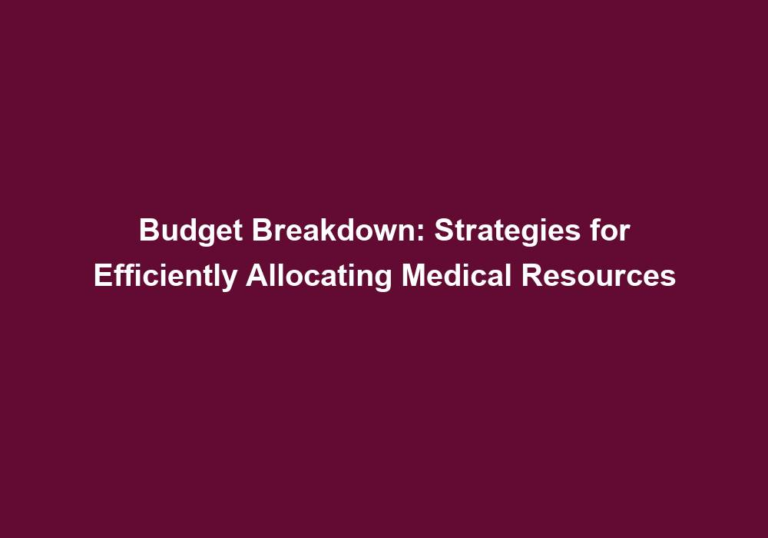Resourceful Returns: Allocating Clinic Resources for Maximum Efficiency
Healthcare clinics play a crucial role in providing essential medical services to communities. To ensure their optimal functioning, it is imperative to allocate resources efficiently. From medical equipment and personnel to patient scheduling and administrative tasks, effective resource utilization can significantly enhance a clinic’s productivity and patient outcomes. This article explores various strategies and best practices for allocating clinic resources to achieve maximum efficiency.
Importance of Resource Allocation in Clinics
Efficient resource allocation is vital for clinics as it directly impacts patient care, staff satisfaction, and overall organizational performance. When resources are utilized optimally, clinics can:
-
Improve Patient Care: By allocating resources effectively, clinics can provide timely and high-quality healthcare services to patients, resulting in better health outcomes and increased patient satisfaction. This includes ensuring a sufficient number of healthcare professionals, medical equipment, and supplies are available to meet patient demand. Additionally, clinics can implement specialized programs or services to address specific patient needs, such as chronic disease management or preventive care initiatives.
-
Enhance Staff Productivity: Proper resource allocation ensures that healthcare professionals have the necessary tools, equipment, and support to perform their duties efficiently, minimizing time waste and improving their overall productivity. This includes providing ongoing training and development opportunities for staff to enhance their skills and stay updated with the latest medical advancements. Additionally, clinics can implement workflow optimization strategies, such as task delegation and streamlined communication channels, to minimize administrative burdens and allow healthcare professionals to focus on patient care.
-
Optimize Cost Management: By efficiently allocating resources, clinics can minimize unnecessary expenses, reduce waste, and allocate budgetary resources appropriately, leading to cost savings and financial stability. This includes implementing inventory management systems to track usage, expiration dates, and reorder thresholds for medical supplies and equipment. By avoiding shortages or excessive stock, clinics can optimize their inventory levels and avoid unnecessary costs. Additionally, clinics can leverage technology solutions, such as electronic medical records (EMRs) and practice management systems, to automate administrative tasks and reduce paperwork, resulting in cost savings and improved overall clinic operations.
Strategies for Resource Allocation in Clinics
-
Assessing Resource Needs: Start by conducting a comprehensive assessment of the clinic’s resource requirements. This involves identifying the types and quantities of medical equipment, supplies, and personnel necessary to meet patient demand and deliver quality care. Consider factors such as patient demographics, service offerings, and anticipated growth to ensure accurate resource allocation.
-
Effective Workforce Management: Efficiently managing healthcare personnel is crucial for resource allocation. Match staff schedules with patient volume trends, ensuring adequate coverage during peak hours. Additionally, consider implementing flexible work arrangements, such as part-time shifts, to accommodate varying patient loads. Regularly evaluate staff workload and adjust staffing levels accordingly to optimize productivity and patient care.
-
Technology Integration: Embrace technology solutions to streamline processes and enhance resource allocation. Electronic medical records (EMRs) and practice management systems can centralize patient information, automate administrative tasks, and facilitate efficient scheduling, reducing staff workload and improving overall clinic operations. Explore telehealth options to expand access to care and optimize resource allocation by providing virtual consultations and remote monitoring for appropriate cases.
-
Prioritizing Patient Needs: Establish a clear triage system to prioritize patients based on their medical condition and urgency. By categorizing patients, clinics can allocate resources accordingly, ensuring timely care for those in critical condition while efficiently managing less urgent cases. Implement protocols and guidelines for patient prioritization to ensure consistent and equitable resource allocation.
-
Optimizing Appointment Scheduling: Implement an effective appointment scheduling system that maximizes the utilization of healthcare professionals’ time. Utilize dedicated scheduling software that considers staff availability, patient preferences, and expected appointment duration. This minimizes wait times, reduces patient no-shows, and enhances overall clinic efficiency. Additionally, consider implementing telemedicine options for appropriate cases to further optimize appointment scheduling and resource allocation.
-
Inventory Management: Efficiently managing medical supplies and equipment is crucial to avoid shortages or excessive stock. Implement inventory management systems that track usage, expiration dates, and reorder thresholds. Regularly review and optimize inventory levels to avoid unnecessary costs and ensure availability when required. Consider partnering with reliable suppliers and negotiating favorable contracts to optimize procurement processes and reduce costs.
-
Streamlining Administrative Tasks: Delegate administrative tasks to trained support staff to free up healthcare professionals’ time for patient care. By optimizing administrative workflows, clinics can enhance overall efficiency and allocate resources where they are most needed. Implement standardized processes and utilize technology solutions, such as automated appointment reminders and online patient portals, to streamline administrative tasks and improve patient experience.
Best Practices for Resource Allocation in Clinics
To optimize resource allocation for maximum efficiency, clinics should consider the following best practices:
-
Regular Performance Evaluation: Continuously monitor and evaluate the clinic’s performance indicators, such as patient satisfaction, wait times, and staff productivity. Identify areas for improvement and implement necessary changes to enhance resource allocation. Utilize data analytics to track key performance metrics and identify trends that can inform resource allocation decisions.
-
Collaboration and Communication: Foster open communication and collaboration among clinic staff. Encourage feedback, suggestions, and ideas for resource allocation improvement from all team members. This enables the identification of potential bottlenecks and the implementation of innovative solutions. Regularly conduct staff meetings and performance reviews to address any concerns and ensure everyone is aligned with the clinic’s resource allocation goals.
-
Continuous Training and Education: Provide regular training and education opportunities for clinic staff. This ensures they stay updated with the latest medical advancements, technology solutions, and best practices for resource allocation, leading to improved efficiency and patient care. Offer opportunities for professional development, such as conferences and workshops, and encourage staff to share their knowledge and expertise with colleagues.
-
Data-Driven Decision Making: Utilize data analytics to make informed decisions regarding resource allocation. Analyze patient data, appointment records, and resource utilization patterns to identify trends and make data-driven adjustments to optimize resource allocation. Implement data collection systems, such as patient satisfaction surveys and electronic health records, to gather valuable insights for resource allocation planning and improvement.
-
Flexibility and Adaptability: Remain flexible and adaptable to changing patient needs, industry trends, and technological advancements. Regularly review and refine resource allocation strategies to ensure they align with the clinic’s evolving requirements. Stay updated with emerging healthcare technologies and industry best practices to identify opportunities for innovation and optimization.
By implementing these strategies and best practices, clinics can achieve resourceful returns through efficient resource allocation. Prioritizing patient care, enhancing staff productivity, optimizing cost management, and embracing technology are key pillars to unlock the full potential of clinic resources.
This article is written by a SEO content writing expert fluent in English.







